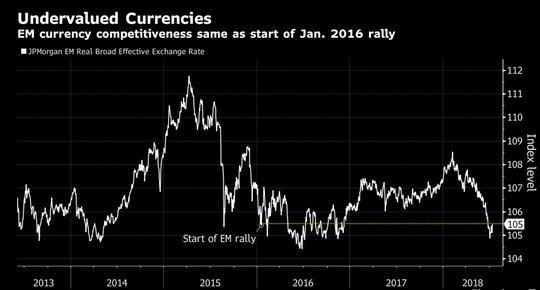The wake-up call last week was that Turkey matters. It’s hard to ignore a 21% weekly drop in FX and say it is a one-off, isolated event. The arguments about idiosyncratic pain trades in emerging markets FX, begins to fall about as the TRY falls 41% on the year today followed with Argentina ARS off 36% on the year, cascading into Russian RUB off 15% year-to-date followed closely by Brazil BRL off 14.25% and ZAR off 12% – all this puts foreign investments into a panic and makes for a tipping point as asset losses pile up and force sales elsewhere.
The root problem for investors is that hedging the FX risks for the above lists cuts into the returns enough to make it less simple – rate spreads and option implied volatility eats away any of the easy gains from growth and value investments. So many jump in and take the risks unhedged in FX and then are forced into stopping out at some line in the sand.
We reached this line again last week for many currencies. This means buying the worst levels after the crisis becomes the game and yet the natural cycle is to face fear of a larger meltdown. Unfortunately, defining an end to a crisis isn’t so simple – Turkey TRY blew past 5 and 6 levels and seems set for 7 and higher unless the Erdogan government can regain credibility for its central bank and for its policies.
Begging citizens to sell gold and buy fiat paper won’t work. Backing the TRY with gold or some other currency (other than the USD given US sanctions and issues) may attract but this risks credibility as well. Money doesn’t stay in nations that don’t play by international rules.
Ripples of Turkey last week became significant waves.The knock-on effect from Turkey to Europe is in EU banks with RUB pain adding to the fear trade. The effect on the rest of the other emerging markets is obvious: USD gains were universal over the year – with the MXN an exception in part because it’s the liquid hedge that didn’t work so well – its up 4% year-to-date as the AMLO election and NAFTA deal hopes rise.
The tipping point risks next week won’t solely be about Turkey but China. The ability for China to ignore the rest of the EM world and to push for stability and battle against the economic pain of US tariffs will be watched in the economic data from retail sales to industrial production to fixed investments. It will be analyzed against their frontier exposures to the Belt-and-Road nations – from Pakistan to Africa.
The CNY is off just 5% on the year – keeping pace with KRW – and the urge for China to keep the CNY stable and hope for investment back into bonds and stocks balances against the pain of exports. The fear is that the pain there is larger and that the Trump administration isn’t going to back down adding to the risks everywhere that nothing is safe abroad – whether you live in Japan or Switzerland or the US.
This begs the return to current account deficits and the cost of money mattering less than the return of it. Whether we have reached that tipping point for a larger market panic remains the central question for the week ahead. The added difficulty will be in the lack of attention and experience given the summer holidays and the urge to blame all moves as speculative and caused by illiquidity. The modest tick up in volatility outside of EM will be a barometer.
The other G10 issue rests with the EUR and CAD. Last week was aggravated by the Italian political focus as the budget plans clash with the EU rules. For Canada, the Saudi weaponization of its investments in the great North became a new risk for CAD where fundamentals point to a 1.28 test and the flow of capital reopens 1.32 instead. So far, the fear in developed markets is modest – the chart of G10 volatility from the DB CVIX makes this clear and the spike up last week doesn’t look like enough to make last week an ending of trouble but more of a tipping point for more.
Question for the Week Ahead: Is this the time to buy EM? Does fear beat greed in the week ahead?
Is this catching a falling knife or should you buy when there is blood on the streets?

The question for the week ahead is whether the EM value proposition (it can’t get much worse) attracts enough money to reverse the ongoing position washouquestion for the week aheads. There are many that suggest you buy when bullets fly and sell when you see the doves of peace.

The bulls for EM will argue that the present Turkey story and the fear of China tariffs leading to a larger global slowdown are overblown compared to the yield and carry opportunities. This isn’t so simple when markets are shrouded in positions that are illiquid and volatility rises. Risk events have long tails when they prove contagious. The pain of last week maybe simple to explain as just a washout of the trades put on in July after the June pain trade. The fact that markets continue to test new lows for TRY and ARS opens focus on BRL and RUB and ZAR in similar ways.

The contagion of EM leading to DM pain shows up first in banks, then in credit. Banks last week looked vulnerable to a capital margin call writ large should TRY trade over 7. This was unthinkable in July and almost reality in August. The biggest story over the summer has been the watch for whether the trade tariffs/sanctions matter to more the focus on just the day-to-day markets and hurt the global economy. The global trade bounce appears to have stalled and turned and that maybe the real story for why buying EM now is still dangerous.


















Leave A Comment